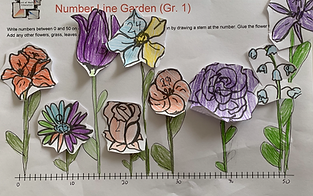Preschool to Grade 1: Spring Theme Activity Handout
Spring Temperatures
-
Each day, record the above zero temperature on this sheet. Shade in the thermometer using different shading techniques (examples provided in the detailed handout. See link at the top). Use warm or cool colours, depending on how the temperature makes you feel. Warm colours: red, orange and yellow. Cool Colours: blue, green and purple.
-
Fill in the time the temperature was taken.
(*Note: Grade 1 students to the nearest hour or half hour)
Geometric Gardens
Geometric shapes have regular appearance and are often manmade.
-
Design a spring landscape garden using:
-
sidewalk chalk
-
shapes cut out of construction paper
-
your own shapes drawn directly on paper
-
these shapes to get you started
*Bonus: Print off the shapes. Cut out one of each and sort them based on characteristics.
-
-
Hide various polygons inside your design (triangles, quadrilaterals, pentagons, hexagons, heptagons and octagons). Create a list or chart with the name of each shape hidden inside and have someone else try to find and count them.
Organic Number Line Garden
Organic shapes are irregular and often asymmetrical and curvy.
-
Print the sheet of flower heads and a number line garden: Preschool - K OR Grade 1.
-
Preschool and Kindergarten: Write a number on each flower between 0 and 20.
-
Grade 1: Write a number between 0 and 50.
-
Place each flower in its appropriate place in the “number line garden” by drawing a stem in the garden where the number should grow.
-
Glue or tape the flower on top.
-
Add any other flowers, grass, leaves or garden components you would like.
Frogs
-
Research the life cycle of a frog.
-
Draw a picture of each phase and describe what happens
-
Present your learning to a family member.
-
Print the sheet "Leaping Lily Pads" to create number patterns in each row. *Note: Grade 1 students count forward by 1's, 2's, 5's, and 10's to 100 and backward by 1's from 20.
-
Play leap frog outside. Have a starting number on the first "lily pad". Give students a value to add or subtract in order to leap from one to the next.
Ladybugs
-
Use the ladybug templates and colour a different number of spots in each wing. Be creative with how you make the spots. Keep the number of spots between 0 and 9. (Or paint ladybugs on rocks).
-
Have someone hide the ladybugs in your yard or house.
-
Find the value of each ladybug by adding the spots.
-
Add up the values once all the ladybugs have been found. If you are playing against someone, the person with a higher total wins.
Plant a Seed
-
Paint or decorate a pot or container to plant a seed.
-
Research the stages of plant development.
-
Once the plant starts to grow, measure it's height each day for a week. Record it's height and the time recorded.
-
Graph results in a bar graph choosing one type of mark making.
-
Try different types of seeds to compare growth.
Flower Petals
-
Print the sheet and fill in the smallest two layers of each petal with numbers between 0 and 20. Put the larger number closest to the middle. Subtract and write the answer on the outer part of the petal.
*Note: For younger students, keep the numbers small and use counters, a number line or two ten frames to help. -
Add colour to the petals by using colours that make you HAPPY. Create a pattern as you colour.


.png)
.png)










